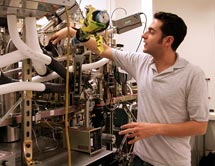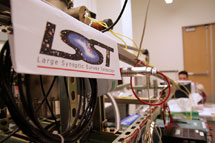
Handy Links
SLAC News Center
SLAC Today
- Subscribe
- Archives: Feb 2006-May 20, 2011
- Archives: May 23, 2011 and later
- Submit Feedback or Story Ideas
- About SLAC Today
SLAC News
Lab News
- Interactions
- Lightsources.org
- ILC NewsLine
- Int'l Science Grid This Week
- Fermilab Today
- Berkeley Lab News
- @brookhaven TODAY
- DOE Pulse
- CERN Courier
- DESY inForm
- US / LHC
SLAC Links
- Emergency
- Safety
- Policy Repository
- Site Entry Form

- Site Maps
- M & O Review
- Computing Status & Calendar
- SLAC Colloquium
- SLACspeak
- SLACspace
- SLAC Logo
- Café Menu
- Flea Market
- Web E-mail
- Marguerite Shuttle
- Discount Commuter Passes
-
Award Reporting Form
- SPIRES
- SciDoc
- Activity Groups
- Library
Stanford
Around the Bay
Jack Singal Braves the Cold
For someone so fond of warm weather, SLAC post-doc Jack Singal has a surprising penchant for extreme cold.
Singal thought he could look forward to five years of California sunshine when he arrived at U.C. Santa Barbara for graduate school in 2002. But his research quickly yanked him eastward, to the NASA Goddard Spaceflight Center in Washington, D.C. "It was kind of a scam," he joked.
Braving the elements proved worth it; that research recently produced some exciting results. Singal was an integral part of the team for ARCADE, the Absolute Radiometer for Cosmology, Astrophsyics and Diffuse Emission. The group sent a giant helium balloon 120,000 feet into the air to seek the heat from the universe's first stars.
Instead, they found a mysterious radio noise six times louder than any signal expected. The signals they sought were drowned in the din. Singal and his colleagues set the cosmology world abuzz when they presented their results at the American Astronomical Society meeting on January 8. No one is sure what the signal means yet, though there has been some wild speculation. "That's not really the point—the point is that it's there," Singal said. "The actual significance of it, it's too early to tell."
Singal designed and built much of the equipment that went aloft with the balloon. "That instrument didn't exist when I started," he said. But some of his work left him cold. His biggest challenge was keeping the instrument at 2.7 degrees above absolute zero by constantly bathing it in liquid helium. The equipment had to stay colder than the cosmic microwave background to ensure that any signals it picked up were real.
Now that his work at ARCADE is done, Singal is relieved to be back in sunny California and working on instrument design for the Large Synoptic Survey Telescope. However, his research subject isn't getting any warmer.
When it is completed in 2014, the LSST will be one of the largest ground-based telescopes on Earth, with a uniquely wide and deep field of view. It will use an enormous digital camera with 3 billion pixels to photograph a large fraction of the sky every few nights, looking for faint or fast-moving objects like asteroids and comets, and probing the depths of the sky for explanations of dark energy and dark matter.
The camera needs to be extremely cold to work at top efficiency, so cold that it must be kept in a vacuum. Because it's so big, all of the electronics have to sit in the vacuum with it. "Otherwise there would just be too many wires," Singal said.
Part of Singal's job is to figure out how the electronics and other materials will behave in the vacuum. "If you put pretty much anything in a vacuum, stuff comes out of it," Singal said. This outgassing could be a problem within the camera. If a gas oozes from part of the telescope and condenses on an electrical circuit or the camera detectors, it could ruin the telescope's ability to take good images.
Singal and his SLAC colleagues Rafe Schindler, Howard Rogers and Chihway Chang are working to figure out exactly what the outgassed materials are, and how bad the damage could be. To do this, they place a piece of material, such as a circuit board or electrical connector, into a humming mass of tubes and wires in the basement of a Stanford physics building, and identify and weigh whatever substances it releases under vacuum. They also let those substances condense on a clear glass surface and measure how much light makes it through, to see if it would obscure light transmission in the camera.
Most other telescopes don't have this problem, so Singal doesn't know what to expect. "The data for how these things behave in a vacuum is pretty much nonexistent," Singal said. "In the end we're going to have to look at everything that isn't a piece of metal."
—Lisa Grossman
SLAC Today, January 28, 2009

